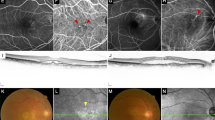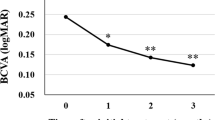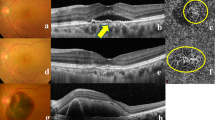Abstract
Purpose A previous study has shown that the pulsatile ocular blood flow (POBF) in eyes with asymmetric age-related macular degeneration (AMD) differs. Whereas eyes with drusen have higher POBF than contralateral eyes with disciform scarring, the POBF of eyes with drusen is lower relative to contralateral eyes with choroidal neovascularization (CNV). This study was designed to assess whether the POBF of eyes with CNV changes after transpupillary thermotherapy (TTT), using the contralateral eyes with drusen or scarring without TTT as controls.
Methods In total, 26 patients with CNV in one eye and drusen or scarring in the other were enrolled in this prospective case series. Eyes with CNV were treated with TTT. POBF was measured monthly in both eyes of each subject.
Results Before TTT, the POBF of eyes with CNV was 1179±317 μl/min. After TTT, the POBF of CNV eyes had decreased at 1 month (1015±273 μl/min, P=0.002) and 2 months (945±398 μl/min, P=0.011) of follow-up, but had rebounded at 3 months (P=0.441) and 6 months (P=0.084).
Conclusions These findings suggest that TTT decreases the pulsatile choroidal blood flow in eyes with CNV in patients with asymmetric AMD and the effects persist for 2 months. POBF may be used as a modality to monitor the therapeutic effects of CNV in asymmetric exudative AMD.
Similar content being viewed by others
Log in or create a free account to read this content
Gain free access to this article, as well as selected content from this journal and more on nature.com
or
References
Mori F, Konno S, Hikichi T, Yamaguchi Y, Ishiko S, Yoshida A . Pulsatile ocular blood flow study: decreases in exudative age-related macular degeneration. Br J Ophthalmol 2001; 85: 531–533.
Chen SJ, Cheng CY, Lee AF, Chou JC, Hsu WM, Liu JH . Pulsatile ocular blood flow in asymmetric exudative age-related macular degeneration. Br J Ophthalmol 2001; 85: 1411–1415.
Reichel E, Berrocal AM, Ip M, Kroll AJ, Desai V, Duker JS et al. Transpupillary thermotherapy of occult subfoveal choroidal neovascularization in patients with age-related macular degeneration. Ophthalmology 1999; 106: 1908–1914.
Ciulla TA, Harris A, Kagemann L, Danis RP, Maturi R, McNulty L et al. Transpupillary thermotherapy for subfoveal occult choroidal neovascularization: effect on ocular perfusion. Invest Ophthalmol Vis Sci 2001; 42: 3337–3340.
The Age-Related Eye Disease Study Research Group. The Age-Related Eye Disease Study (AREDS): design implications. AREDS report no. 1. Control Clin Trials 1999; 20: 573–600.
Williamson TH, Harris A . Ocular blood flow measurement. Br J Ophthalmol 1994; 78: 939–945.
Liang KY, Zeger SL . Longitudinal data analysis using generalized linear models. Biometrics 1986; 73: 13–22.
Kiel JW . The effect of arterial pressure on the ocular pressure–volume relationship in the rabbit. Exp Eye Res 1995; 60: 267–278.
Schmetterer L, Dallinger S, Findl O, Strenn K, Graselli U, Eichler HG et al. Noninvasive investigations of the normal ocular circulation in humans. Invest Ophthalmol Vis Sci 1998; 39: 1210–1220.
Lanzetta P, Michieletto P, Pirracchio A, Bandello F . Early vascular changes induced by transpupillary thermotherapy of choroidal neovascularization. Ophthalmology 2002; 109: 1098–1104.
Yang YC, Hulbert MF, Batterbury M, Clearkin LG . Pulsatile ocular blood flow measurements in healthy eyes: reproducibility and reference values. J Glaucoma 1997; 6: 175–179.
Author information
Authors and Affiliations
Corresponding author
Additional information
Presented in part at the Annual Meeting of the Association for Research in Vision and Ophthalmology, May 2002, Fort Lauderdale, FL, USA.
Rights and permissions
About this article
Cite this article
Chen, SJ., Cheng, CY., Lee, AF. et al. Pulsatile ocular blood flow of choroidal neovascularization in asymmetric age-related macular degeneration after transpupillary thermotherapy. Eye 18, 595–599 (2004). https://doi.org/10.1038/sj.eye.6700723
Received:
Accepted:
Published:
Issue date:
DOI: https://doi.org/10.1038/sj.eye.6700723



